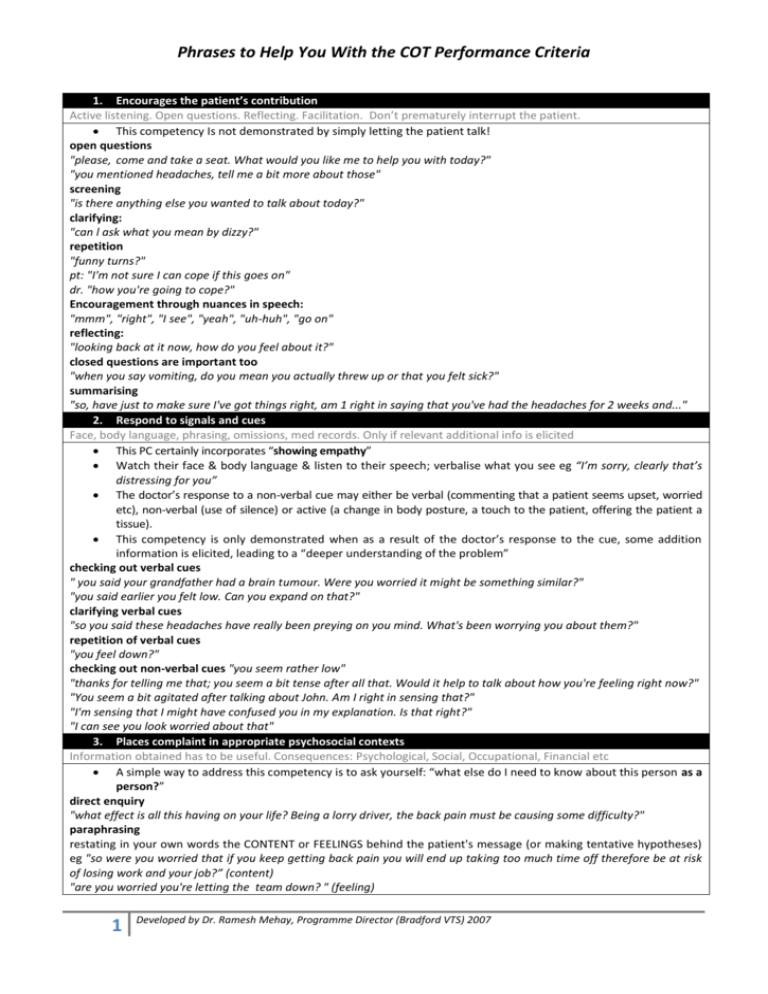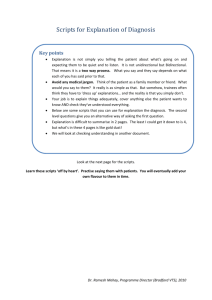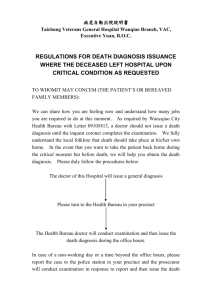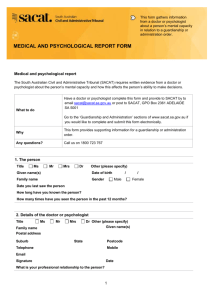cot - useful phrases for eliciting the criteria
advertisement

Phrases to Help You With the COT Performance Criteria 1. Encourages the patient’s contribution Active listening. Open questions. Reflecting. Facilitation. Don’t prematurely interrupt the patient. This competency Is not demonstrated by simply letting the patient talk! open questions "please, come and take a seat. What would you like me to help you with today?" "you mentioned headaches, tell me a bit more about those" screening "is there anything else you wanted to talk about today?" clarifying: "can l ask what you mean by dizzy?" repetition "funny turns?" pt: "I'm not sure I can cope if this goes on" dr. "how you're going to cope?" Encouragement through nuances in speech: "mmm", "right", "I see", "yeah", "uh-huh", "go on" reflecting: "looking back at it now, how do you feel about it?" closed questions are important too "when you say vomiting, do you mean you actually threw up or that you felt sick?" summarising "so, have just to make sure I've got things right, am 1 right in saying that you've had the headaches for 2 weeks and..." 2. Respond to signals and cues Face, body language, phrasing, omissions, med records. Only if relevant additional info is elicited This PC certainly incorporates “showing empathy” Watch their face & body language & listen to their speech; verbalise what you see eg “I’m sorry, clearly that’s distressing for you” The doctor’s response to a non-verbal cue may either be verbal (commenting that a patient seems upset, worried etc), non-verbal (use of silence) or active (a change in body posture, a touch to the patient, offering the patient a tissue). This competency is only demonstrated when as a result of the doctor’s response to the cue, some addition information is elicited, leading to a “deeper understanding of the problem” checking out verbal cues " you said your grandfather had a brain tumour. Were you worried it might be something similar?" "you said earlier you felt low. Can you expand on that?" clarifying verbal cues "so you said these headaches have really been preying on you mind. What's been worrying you about them?" repetition of verbal cues "you feel down?" checking out non-verbal cues "you seem rather low" "thanks for telling me that; you seem a bit tense after all that. Would it help to talk about how you're feeling right now?" "You seem a bit agitated after talking about John. Am I right in sensing that?" "I'm sensing that I might have confused you in my explanation. Is that right?" "I can see you look worried about that" 3. Places complaint in appropriate psychosocial contexts Information obtained has to be useful. Consequences: Psychological, Social, Occupational, Financial etc A simple way to address this competency is to ask yourself: “what else do I need to know about this person as a person?” direct enquiry "what effect is all this having on your life? Being a lorry driver, the back pain must be causing some difficulty?" paraphrasing restating in your own words the CONTENT or FEELINGS behind the patient's message (or making tentative hypotheses) eg "so were you worried that if you keep getting back pain you will end up taking too much time off therefore be at risk of losing work and your job?” (content) "are you worried you're letting the team down? " (feeling) 1 Developed by Dr. Ramesh Mehay, Programme Director (Bradford VTS) 2007 Phrases to Help You With the COT Performance Criteria 4. Explore patient’s health understanding ICE (Ideas, Concerns & Expections). Only if additional info is actually elicited. It is always possible, and almost always desirable, for the doctor to be aware of what the patient thinks about their problem. Nearly all patients will have mulled over in their minds something about their illness. Bluntly asking “what do you think is the matter?” is likely to generate the reply “I don’t know, you’re the doctor” By sensitively exploring this area, you can usually discover relevant belief, which may need fine tuning or modifying entirely if you want your explanation to be accepted (patients are “experts” in their own lives!). If a patient says “I don’t know”, persistence may be necessary or you may need to come back to it later once rapport is more firmly established. sharing your thoughts: "sometimes, headaches like these can be brought on by stress. I was wondering whether you felt this was true for you in light of what you’ve told me about what’s happening at work. What do you think?" sharing patient's thoughts "tell me about your thoughts and feelings" “what would be your worst fear with these symptoms” using tentative hypotheses Use of tentative hypotheses might help to encourage the patient to open up eg “were you worried that the rash might be infectious with you working in a school?” IDEAS "When people have problems like these, they often have thoughts about what it might be. I'd be interested to know if you any thoughts around what might be causing it?" 'you've obviously been thinking about this a lot recently. It would help me to know what you were thinking it might be" CONCERNS "Is there anything you're worried this might be?" "What was the worst thing you were thinking this might be" "is there anything particular that was worrying you about it – had you for instance read something about it or may be some friends and relatives said something that worried you?" pt: "Do you think it might be an allergy dr?"; dr: "what makes you think it might be?" EXPECTATIONS "what were you hoping that I might be able to do for you today?" "you've obviously given this some thought. I'd be interested to know what you thought would be the best way of tackling this; the way that I might help you the most?" 5. Includes or excludes likely relevant significant condition Sufficient history: PC, PMH, relevant symptoms to exclude relevant significant conditions. This is the medical safety PC. It doesn’t necessarily occur at any particular stage: it may happen during an examination, or later, during the explanation, or even as an afterthought “significant condition” means either other differential diagnoses or serious conditions for most problems there are certain "medical" questions that need to be asked, for the consultation to be considered "safe" (i.e. excluding red flags/alarm symptoms). It does not mean that the doctor has to go into every conceivable detail or chase rare diagnoses. Examples: suicide in depression, malignancy in chronic cough, change in bowel habit, dysphagia, weight loss etc Closed focussed questions help with this like: "so, with these headaches, have you had any vomiting? Changes in your vision?" etc 6. Appropriate physical or mental state examination Choice of examination should be appropriate. Outline intended examination to patient APPROPRIATE examination which Is chosen to confirm or disprove a suspected diagnoses (=help sort out which of the differential diagnoses is likely) OR to address a patient’s concern (eg “I think it’s gone onto my lungs doctor”). Intimate examination should not be recorded! This competency is simply about the choice of examination, not about the competency in performing it. Signpost & Explain "is it okay for me to examine your chest, to see whether there is any bronchitis" Sensitivity where it is due "I'm sorry if this examination is embarrassing for you. I’ll try to make it as quick and easy as I can" 2 Developed by Dr. Ramesh Mehay, Programme Director (Bradford VTS) 2007 Phrases to Help You With the COT Performance Criteria 7. Appropriate working diagnosis Does not necessarily need to be expressed as a "disease" eg “stress related headache", dyscopia, “unexplained fatigue”. It’s in the explanation (competency 8 below) where your trainer/assessor will pick it up. It’s important to have a “working diagnosis” as it forms the basis for the subsequent competencies of explaining and managing the condition. 8. Explain problem / diagnosis in appropriate language Plain English. Avoid jargon. Check understanding/acceptance Start with patient's starting point Dr: "I don't know how much you know about asthma?" Pt: "Well... I know a friend who has it" Dr.. "It would be good if you could tell me more about what you already know from your friend so that I might be able to fill in the gaps" ........ Dr. "There's quite a bit of information on diabetes. It's not a small subject. Some people like to know lots about it and others much less so. How much information would you like today?" Pt: "I'm not sure I'm in a proper state to take it all in. How about giving me some stuff to read and I'll come back next week with my wife to talk more?" use patient's words eg "yeah, what you describe as blotchiness is as you said an allergy. Can I check to see what you understand by the word allergy?" sharing doctor's thoughts: "would it be helpful to talk about what I think is going on and then we can see how you feel about it. Okay then..." Chunks and Checks Dr.' "The type of headache you are describing is called a migraine. Migraines are quire often associated with the visual thing that you describe. Nobody really knows why migraines happen but it is thought to be linked to the blood flow to the brain. It's not serious though although it can be very troublesome. Does that make sense to you?" Pt: "Yes, I heard somethings can make it bad though like chocolate?" Ask what other info the patient would like "do you have any questions you'd like me to answer or any points that I haven't covered?" Give explanation at appropriate times Pt: "Also, I think I’ve got a chest infection and needs some antibiotics" Dr. "That's interesting. Would you mind if I put that on hold just for a second and come back to it after I've asked you a bit more about your low moods?" AIDING RECALL THROUGH CATEGORISATION Signposting "There are three important things I'd like to explain. First I'd like to tell you what I think is going on. Second, what tests make we need to do and third, how to make it better” “It’s very important you remember this next bit" Repetition/Summarising "So, just to recap, think you're headaches are called migraines. To help make you better it would be good if...." Don't forget to use leaflets and visual aids where appropriate. ( & Always Summarise) IF YOU WANT TO GET AN “EXCELLENT” GRADE: INCORPORATE THE PATIENT’S HEALTH BELIEFS (=ideas, concerns & expectations) WHEN EXPLAINING THE PROBLEM Remember what we said earlier: “patients are experts in their own lives” and therefore if you want them to accept your diagnosis/explanation of what is going on (when it is at variance with theirs for example), then you need to start of with their perceptions/thoughts and explain why you think it is not that or modify them so they synchronise with yours. Essentially it requires a reference back to patient-held ideas during the explanation of the problem/diagnosis. Do this and a patient is more likely to engage with subsequent management too, because now they understand where you are coming from and have faith in you. "You mentioned earlier that you were concerned that you might have angina. I can see why you might have thought that, but in fact I think it is more likely to be muscular pain. Let me explain why I don't think it is angina." "this rash is called psoriasis, and is caused by overactive cells in the skin, but it is probably not affected by what you eat" (having elicited food concerns earlier) "Yeah, I think your right: your irritable bowel syndrome is very likely to be related to the stress you were telling me about earlier" 3 Developed by Dr. Ramesh Mehay, Programme Director (Bradford VTS) 2007 Phrases to Help You With the COT Performance Criteria 9. Seek to confirm patient’s understanding “Does that make sense to you; anything you want to ask?” Offer to explain to a third party. Enhance concordance, by exploring and responding to the patient’s understanding of the treatment There are two elements to this: 1. Seek to confirm understanding of the diagnosis and 2. Seek to confirm understanding of the treatment. A cursory “Is that OK?” or the patient simply nodding is not enough. It must be an active seeking out of the patient’s understanding. SEEK TO CONFIRM PATIENT’S UNDERSTANDING OF THE DIAGNOSIS: This should be a routine task performed in all consultations; except where it is blatantly obvious This is not demonstrated by "is that clear?" to which the answer is usually "yes doctor". Have you confused them? "I don't know whether that makes sense, is there anything you want me to clarify on or to ask me?" "I’ve given a lot of information to you today and I wondered whether I've confused you. Is that right?" "I'm worried I've confused you with all the information I've given you today. It would help me if you could repeat back to me what we've agreed so far so I can make sure we're both on the same track" How will they explain it to someone else "what are you going to say when your wife asks you about what the problem is when you get back home?" Explore feelings after diagnosis "how do you feel now that I've explained that to you?" "What questions does it leave you with?" "Is there anything I haven't covered or explained?" "I'm not sure how that explanation (or news) has left you feeling...." "You still seem a bit anxious over what I've said..." (pause) SEEK TO CONFIRM PATIENT’S UNDERSTANDING OF THE TREATMENT This competency is based on the evidence that most patients do not adequately understand their treatment, nor take it as intended. There two elements when seeking to confirm the patient’s understanding of the treatment: 1. exploring the patient's understanding of the treatment (similar to competency 9: seeking to confirm patient’s understanding of the diagnosis) 2. a reactive explanation of the treatment in the light of this. Phrases that will help you are similar to those in "seek to confirm patient's understanding of diagnosis", namely: Have you confused them? "I don't know whether that plan makes sense, is there anything you want me to clarify on or to ask me?" "I’ve given a lot of information to you today and I wondered whether I've confused you. Is that right?" "I'm worried I've confused you with all the information I've given you today. It would help me if you could repeat back to me what we've planned so far so I can make sure we're both on the same track" How will they explain it to someone else "what are you going to say when your wife asks you about what we’re going to do about it when you get back home?" Explore feelings after explanation of the management plan "how do you feel about that plan?" "What questions does it leave you with?" "Is there anything I haven't covered or explained?" "I'm not sure how that plan has left you feeling...." "You still seem a bit anxious over what I've said..." (pause) 10. Appropriate management plan Should relate directly to the working diagnosis and must represent good current medical practice. EBM. Management doesn’t just mean drugs…. It includes referrals, follow up and much more Don't forget to write the plan down for the patient if it seems too complicated eg chlordiazepoxide reducing regime for those who want to come off alcohol 11. Involve patient in management plan Give & explain appropriate options. Shared Decision Making. Negotiation. Not all patients will want to make a choice between therapies (around 30% of patients according to research) and some will want you to decide BUT they should all be offered the opportunity to be involved in the process Seek Permission: ask rather than dictate "How would you feel about seeing a stress counsellor" as opposed to "I am going to refer you to a stress counsellor" Offer Options (eg drug, non-drug, referral, watchful waiting, etc) "Let 's work through the options available to us and tell me if you have any thoughts about them" "Given what you have said, I think there are two choices available that we ought to consider together – first starting HRT now or second simply soldiering on for the moment and seeing what happens to your symptoms over the next few 4 Developed by Dr. Ramesh Mehay, Programme Director (Bradford VTS) 2007 Phrases to Help You With the COT Performance Criteria months. Do you have a preference?" "You've probably thought a lot about this too. Were those the choices you had in mind or did you have some other thoughts?" When The Patient Doesn’t Want to Make A Choice This competency can be demonstrated even if the patient doesn’t want to make a choice but instead asks you to do so: so long as you’ve got them involved in the process eg “okay, I think because you’ve only had it for a week so far, we should keep an eye on it and let’s see what happens to it when you come and see me in 2 weeks. Do you think that’s reasonable?” When the doctor has a strong preference "In this particular instance, from a purely medical standpoint, given your strong FH of heart problems and that the calculation showed you’re at very high risk, I think that you would be best to take the medication to reduce your BP. However, we still need to take your feelings and thoughts into account here." If the doctor doesn’t agree with the patient's preference "I do have some reservation about taking the approach you suggest. Can I explain them to you and then perhaps we can try to find a solution that we’re both happy with?" (Summarise) 12. Make Effective Use of Resources This criterion relates to the doctor using resources effectively (e.g. effective use of time, other health professionals, referrals, online material, patient information leaflets). Don’t forget, sharing your computer screen with the patient and exploring online stuff together can be a very effective way of imparting information as well and “keeping you right” clinically. 13. Specify F/U conditions & interval Clear reference to further contact. Time Scale clearly stated. “Safety-netting.” This competency would not be demonstrated unless there was a reference to further contact. It is better to state a return date in terms of a day rather than a numerical period because patients have to do some calculating with the latter (even if it is simple to you and I): eg “If things aren’t any better in 10 days time, come back” is better said: “Well, let’s see, today is Tues, so I would definitely expect things to start getting by the weekend. Listen, if things aren’t any better say a week on Friday (not this Friday but the Friday after) why don’t you come back and see us? What do you think?” (extra time taken = perhaps 3 seconds?) First, SUMMARISE. “So, just to recap, I think that what you getting is blah, blah blah and that to try and help relieve it we should blah, blah, blah.” Then state follow-up period “However, if it is not improving in a week’s time, please come back to let me have another look" "can l see you again in two weeks, but sooner if you are worried or if you get...." Then safety-net – state explicitly what symptoms should necessitate an earlier return. "what I mean when I say if its not improving is if you start to develop any vision, vomiting or sleep problems as a result of these headaches." “Come back if for example the pain seems to be getting a lot worse after 7 days. Most of the time viral sore throats do settle within this time but sometimes, if the pain lingers on, it could mean that it is something else like tonsillitis. So do make sure you comeback if this happens. Okay?” Ensure you’ve linked the time scale to symptoms The time scale for the patient to return for review should be linked with symptoms or some other parameter (eg peak flow) and should be appropriate to the risk eg”I think things will settle in around 7 days. But if the vomiting gets worse, for instance, you can’t even keep fluids like water down, please come back sooner”; “well, your chest doesn’t sound too bad today. Why don’t you keep an eye on your peak flows and if they fall below 400 or if your breathing gets worse or it’s simply not settling, come back straight away.”; “Let me see you in 2 weeks to see how your getting on but earlier if you start to get blah, blah or blah. How does that sound?”. I strongly recommend getting hold a copy of Skills for Communicating with Patients by Jan Van Dalen, Jonathan Silverman, Suzanne Kurtz, and Juliet Draper (the yellow book, not the green one). Read it and practice some of the skills & phrases. 5 Developed by Dr. Ramesh Mehay, Programme Director (Bradford VTS) 2007








